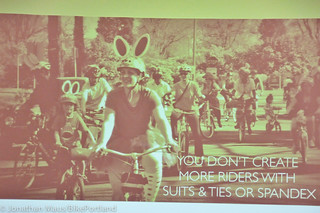
suits and ties and spandex,” reads a slide
from Lily Karabaic’s presentation.
(Photos by J. Maus/BikePortland)
—BikePortland’s coverage from Washington D.C. is made possible by Planet Bike.
The National Women’s Cycling Forum is like a day-long master class in how to infect women and communities with the bicycling bug. For the hundreds of professional advocates and rising-star activists in attendance, there is a ton of great advice and inspiration being offered up. In one session this morning, Cultivating the All Powerful Bike Lobby, we were introduced to several women on the front lines of community-based bike advocacy.
The session was moderated by Leah Shahum, the 13 year veteran leader of the 12,000 member San Francisco Bicycle Coalition. She knows a lot about the bike lobby and the power that can come with putting it to use. Early in her career, Leah shared, she was “nervous” about the idea of power. It seemed like some sinister force and the idea of using it to her advantage was “difficult to grasp.” But years into her advocacy career, she’s figured it out. “I realized in the end that power is all about people… It’s about people’s stories and connecting people who make decisions with people in communities who have a different kind of power.”
But how can advocates for bicycling make that connection stronger?
Nona Varnado faced that challenge head on when she launched a bike fashion line in 2008. “I realized the market didn’t exist yet,” she told the crowd, “so I had to develop the market myself.” So Varnado went to work. She started The Ladies Program, a series of events “for people who don’t identify as bicyclsits” during bike month in New York City. By creating alliances and focusing on collaboration — not competition — with other groups, Varnado found her niche. She has since move to Los Angeles where she opened a storefront that serves as a community meeting space, gallery, and product pop-up shop. Now Varnado leads a new non-profit dubbed The Bicycle Culture Institute (FB) and she works with L.A. Bike Trains.
Along the way, Varnado learned a lot and had several several tips to share. Here are a few I wrote down:
- Even if three people show up to your event, photograph the hell about if it.
- Adopt a philosophy of abundance — give your time and experience to others who are passionate about the same topics.
- Reject the idea that there’s only enough money, jobs, audience to go around. (This is the biggest problem advocates have.) A rising tide and a unified community floats all boats and grows beyond any niche.
- Importance of participation. Unless people show up it doesn’t count. And the best way to get folks to show up is to show up to other people’s events. Support efforts beyond your circle and contribute to them financially.
Varnado is right. Getting people to show up to events is the building block of a healthy bike culture. And the best way to get people out into the streets — so says Portlander Lilian Karabaic — is to “put the fun before the wonk.”
Karabaic (who also happens to be the producer of the BikePortland Podcast) wasted no time in getting the crowd’s attention. “We’re doing things wrong,” she said at the outset of her presentation, “If we were doing things right we wouldn’t have a women’s bicycling forum, we would have a National Bike Summit with equal representation of women and men.” Karabaic earned a hearty applause for that line, and it was the first of many during her very well-received talk.
Advocates spend too much time talking about wonky topics like infrastructure details and they spend too much time “guilt-shaming” people by touting bicycling’s many (and quite mundane) benefits. And Karabaic’s pet peeve is how much of the advocacy discussion revolves around commute trips (trips to work). Instead, she urged, advocates should spend more time on “bike fun.” “We should be talking about costumes not concrete,” she said. (It’s worth mentioning that Karabaic’s past jobs include organizing the World Naked Bike Ride and leading the Bowie vs. Prince ride during Pedalpalooza).
“Kids ride because it’s fun. In my case I rode to hang out with the cool kids… But how do we keep them riding? We won’t keep them riding bike talking about concrete and curb-cuts,” Karabaic said, “What keeps them riding is fun.” All the talk from the “helmet mirrors and padded buts crowd,” about gear, helmets, lane positioning, tire width and hand signals, she added, is doing nothing to get more people on bikes.
And Karabaic raised an important point about the focus on commute trips. Not only is commuting to work inherently not a fun activity for most people, but, Karabaic said, “It’s based on a privileged perspective.” “It’s a luxury that you live close enough to bike to work.”
Why is all this important to the work of getting more women on bikes? Because women are more likely to be interested in social activities and they tend to take on more childcare responsibilities in the home. “If we focus on the journey to work we’ll never have an equal number of women riding bikes as men.”
The ideas shared by Karabaic, Varnado and all the other thought-provoking women here at the Forum have forced attendees to think. Similar to last year, the ideas and energy at this event have a newness and urgency that the more formal National Bike Summit seems to be lacking these days. To the League’s credit, the Women’s Forum is capturing a movement that is growing right before our eyes. And the women involved in it are giving other advocates a lot of ideas to steal and take back to their respective communities.




